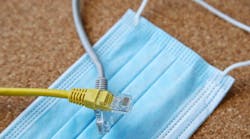Latest from FTTx/Optical Networks
FTTH Installation Techniques for COVID-19 Safety Concerns
COVID-19 is teaching all of us the importance of home broadband connections, whether it is work from home or staying connected with family and friends. We know that Fiber-to-the-Home (FTTH) is a key broadband deployment architecture.
Since COVID-19 has heightened our sensitivities to health, safety, and personal contact, how can service providers install and maintain new services given the new normal? There is a need for new and inventive methods and procedures to provide service quickly and with limited personal contact. The best way to accomplish this is with customer self-installs.
InvisiLight® Solution for Deploying Fiber
April 2, 2022Go to Market Faster. Speed up Network Deployment
April 2, 2022Episode 10: Fiber Optic Closure Specs Explained…
April 1, 2022Food for Thought from Our 2022 ICT Visionaries
April 1, 2022We have experience with customer DSL self-installs that were very successful. We have also seen:
• a significant reduction in the time needed for FTTH installations
• reduced equipment size, such as desktop ONTs
• ease of installations
Let’s take those learnings and adapt them to customer self-installs for FTTH. The main difference, compared to many current FTTH installations, is having the customer install the ONT and fiber connections.
Customer Self-Installs for FTTH
It’s time to get innovative with a few alternatives for varied applications and customers. A few ideas to explore are:
1. Create a FTTH-in-a-Box Customer Kit.
This kit would deliver all the customer needs for a successful self-install.
• Installation Instructions – both written and audio
• Virtual Tech Support if requested by the customer via a Facetime, Skype, or Zoom session
• Desktop ONT
• Wi-Fi Gateway
• Ruggedized Fiber Drop Cables (This could be with or without fiber connector body attached). These cables remain flexible even in extreme conditions and their assemblies use bend-insensitive fiber. These cables can be provided without the connector body allowing them to go through small holes. Then the connector body can easily be snapped on by the customer.
• Indoor Peel-Able Adhesive-Backed Fiber Cable for routing, with optical connectors already attached.
• Ethernet Cable
• Easy-to-Use Contact Pad for cleaning the fiber end-faces of the fiber connectors
• Registration and Activate Instructions
2. Another option is to install a demarcation point or box outside the home for the customer to connect to. The carrier can connect the fiber optic drop wire to the demarcation box, and then slip it through a ruggedized fiber drop cable without the connect body inside the home. The customer would then snap on the connector body, clean and install into the ONT.
3. In apartment buildings fiber could be run down the hallway with a small demarcation box over each apartment door. Again, all that is needed is for the service provider to drill a small hole to push the fiber into the apartment, and click the fiber jumper in place.
4. In certain installations, there could be interim solutions, such as providing a peel-able flat drop cable that could slip through a customer’s window. Using bend insensitive fiber, this could be done with only a 0.5 dB loss, while still allowing the customer to close their window. Then at a future time, a more permanent solution could be installed.
Like this Article?
Subscribe to ISE magazine and start receiving your FREE monthly copy today!
5. There may be different solutions for single family homes and multi-family dwellings. All the necessary components needed for the installation (including ONT, coiled drop cable) could fit in the size of a small milk crate.
The key is for the industry and service providers to embrace this time as a creative nudge for innovation across the networks.

Ernie Gallo | Director at Network Infrastructure Solutions, a division of Ericsson, Inc.,
Ernie Gallo is Director at Network Infrastructure Solutions, a division of Ericsson, Inc., and an IEEE C2 National Electrical Safety Code - Committee Member, Subcommittees SC2, SC4, SC5, and SC8. He has more than 40 years of experience in outside plant products, requirements, deployment, and electrical safety codes and standards such as the NEC and NESC. For more information, please email [email protected] or visit https://www.ericsson.com/en. Follow Ericsson on Twitter @ericsson.
For more information, please visit https://standards.ieee.org/products-programs/nesc/ to learn more information about the NESC and NESC Products. Follow the IEEE SA on Twitter @IEEESA. We welcome you to contribute to our efforts by joining the NESC.








